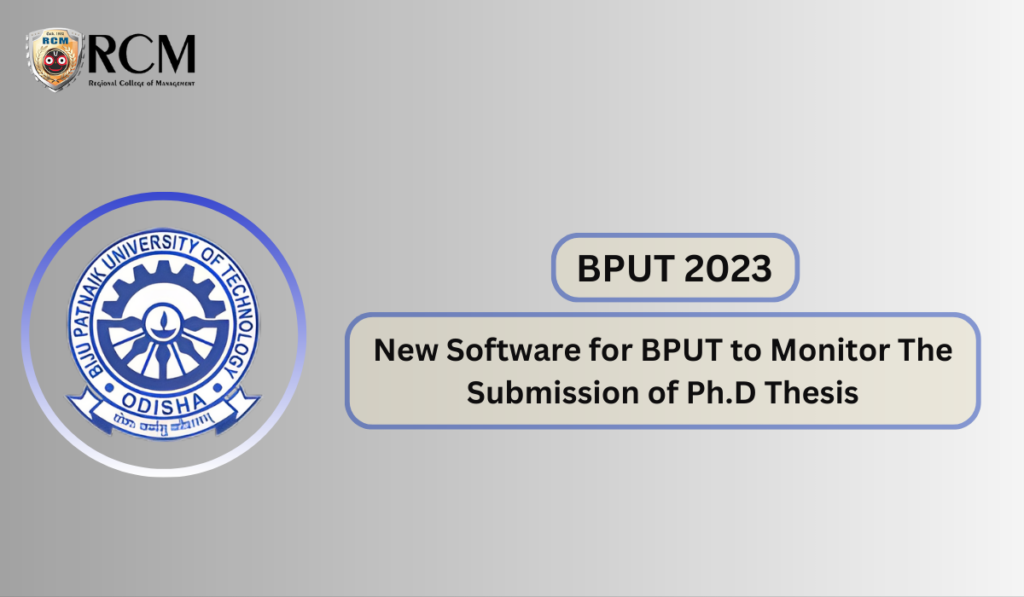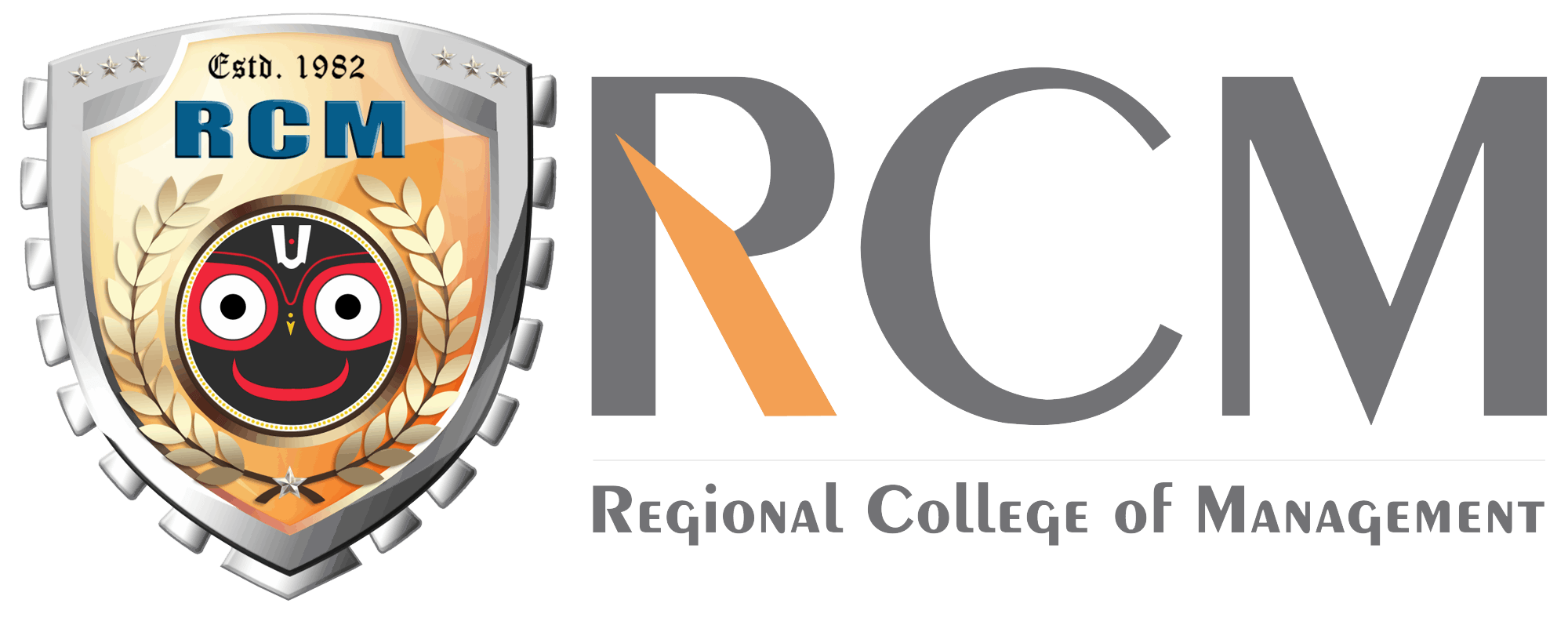
Home ► New Software for BPUT to Monitor The Submission of Ph.D. Thesis


New Software for BPUT to Monitor The Submission of Ph.D. Thesis
- By rcmadmin
- May 30, 2022
- No Comments
The Biju Patnaik University of Technology (BPUT ) has developed a program to monitor the progression of Ph.D. work from pre-submission to degree conferring. The supervisor of the research project can monitor the submission process, outside experts’ views, and other factors up until the degree is awarded.
“The software should be ready by July. Once ready, the guide (which can be an assistant professor/associate professor/professor ) can log in to this software and see the progress of his/her Ph.D. scholars’ thesis work after pre-submission,” Amiya Kumar Rath, the vice-chancellor of BPUT , said on Monday.
After the pre-submission of the thesis, the guide can see the comments given by the experts on the thesis. “Similarly, after submission of the Ph.D. thesis, it will show the date of submission and acceptance by the external examiner. If the external examiner has not accepted it, the external will get an auto-generated mail for the same,” Rath added.
Official sources said the software will show a timeline for receiving reports regarding the Ph.D. thesis. “If it does not on the platform, the external will get an auto-generated mail again on this,” Rath added.
(Source: Times of India )
Visit RCM, Bhubaneswar to stay updated on OJEE Blogs and news .
Note: the regional college of management, bhubaneswar the foremost college of odisha is now offering scholarships for admission in 2023. limited seats are available , you might also like.

Gita Gopinath: A Trailblazing Economist and Leader at the IMF

Changing Face of Employment Relations; Equity & Diversity.

Impact of Globalization on Odisha
Regional College Of Management (RCM College) is a Leading education provider with foremost facilities essential for the all-round development of a student.
Admission 2024
Rcm, bhubaneswar, ranked as the 4th best business school in eastern india., bba | bca | mba | pgdm | mca | ma-ta.

Recent Posts

Leave a Comment Cancel
Your email address will not be published. Required fields are marked *
Email Address: *
Contact Info
Plot No. GD 2/12 & 13 Chakadola Vihar, Chandrasekharpur, Bhubaneswar-751023
City Office:
Directors Chamber’s, #203, Plot No. B15, 2nd Floor, Swash lane, Sahidnagar, Bhubaneswar - 751007, Odisha
+91 90900 80801
1800 1214 357
Quick Links
- RCM Diaries
- Mandatory Disclosure

The Advantages of Pursuing PGDM After B.Com, @RCM

Unlocking Academic Excellence: Regional College with the Best Faculty and Distinguished Instructors
Regional College of Management (RCM), Bhubaneswar, the first management college in Odisha, was established in 1982. The college has been approved under section 2(f) and 12 (b) of the UGC Act. The institute has been conferred the status by UGC in the year 2009. It is the first management institute in Eastern India conferred by the University Grants Commission. The institute since its inception, developed immensely in all areas of management education.

NAAC to Soon Replace a New Body for Accrediting Medical Colleges

Government of Odisha to Review Infrastructure Gaps in Degree Colleges
Get all latest content delivered to your Email a few times a month.

- RCM INSIGHTS RCM INSIGHTS
- PROGRAMS PROGRAMS
- STUDENT LIFE STUDENT LIFE
- FACULTY FACULTY
- ALUMNI ALUMNI
- RCM DIARIES RCM DIARIES
- TESTIMONIALS TESTIMONIALS
- PLACEMENT @ RCM PLACEMENT @ RCM
- ADMISSIONS ADMISSIONS
- Career Career
- Notices Notices
- Contact Us Contact Us
- Downloads Downloads
- News / Blogs News / Blogs
- Mandatory Disclosure Mandatory Disclosure
RCM INSIGHTS
- RCM Legacy RCM Legacy
- About RCM About RCM
- The Journey The Journey
- From the Light Bearer From the Light Bearer
- Chairman's Desk Chairman's Desk
- Director's Desk Director's Desk
- Board of Governance Board of Governance
- Endorsement @ RCM Endorsement @ RCM
- Ranking, Recognitions & Accreditations Ranking, Recognitions & Accreditations
- Award & Achievements Award & Achievements
- Global Footprints Global Footprints
- RCM Network RCM Network
- Ecosystem @ RCM Ecosystem @ RCM
- Ombudsman Ombudsman
- Campus Campus
- Policies Policies
- Teaching Pedagogy Teaching Pedagogy
- Skill Development Cell / PHD Cell Skill Development Cell / PHD Cell
- ACADEMIA ACADEMIA
- U.G. Programs U.G. Programs
- P.G. Programs P.G. Programs
- PGDM+ PGDM+
- MATA+ MATA+
- Placements Placements
- Research & Publications Research & Publications
- Scholarships Scholarships
- Mentoring System Mentoring System
- Class Attendance Class Attendance
- Academic Honesty Academic Honesty
- Skill Enhancement Skill Enhancement
- Collaboration-Effective Learning Collaboration-Effective Learning
- We Care We Care
- Academic Calender Academic Calender
- Examination Cell Examination Cell
- Student Committees Student Committees
- Grievance Cell Grievance Cell
- Anti- Ragging Committee Anti- Ragging Committee
- Internal Complaint Committee Internal Complaint Committee
- Student Exposure Student Exposure
- Student Services Student Services
- Student Notice Student Notice
- Teaching Faculty Teaching Faculty
- Current Faculty Current Faculty
- Ex-Faculty Ex-Faculty
- Distinguished Faculty Distinguished Faculty
- Director Director
- Academic Council Academic Council
- Advisory Board Advisory Board
- Board of Council Board of Council
- Guest Faculty Guest Faculty
- Alumni Profiles Alumni Profiles
- Alumni Testimonials Alumni Testimonials
- Popular Members Popular Members
- Blogs Blogs
- Vlogs Vlogs
- Event & News Event & News
- Media Coverage Media Coverage
- Gallery Gallery
- MBA Fresher Party 2022 MBA Fresher Party 2022
- BBA/BCA Fresher Party BBA/BCA Fresher Party
- MBA Farewell Party 2022 MBA Farewell Party 2022
- Webinars / Seminars Webinars / Seminars
- TESTIMONIAL'S TESTIMONIAL'S
- Students Students
- Faculty Faculty
- Alumni Alumni
- Placement Insights Placement Insights
- Overview Overview
- Current Placement Updates Current Placement Updates
- Placement Cell Placement Cell
- Training & Placement Training & Placement
- Management Development Program Management Development Program
- TOT Reading Program TOT Reading Program
- Company Program Company Program
- Road to Excellence Road to Excellence
- Summer Internship Programs Summer Internship Programs
- Placement Record Placement Record
- Year Wise Year Wise
- Batch Wise Batch Wise
- Our Recruiters Our Recruiters
- How to Apply How to Apply
- U.G. Program U.G. Program
- P.G. Program P.G. Program
- Secureload Application Secureload Application
- RCM Scholarships RCM Scholarships
- Fee Structure Fee Structure
- APPLY NOW APPLY NOW
Resource Center
Are you struggling with your thesis writing? Do you need help with research paper formatting or research paper review? Look no further! Our website offers a comprehensive range of resources to help you with all aspects of thesis writing, from choosing a topic to formatting your final document.
Here are some of the things you can find here:
- University assignment format: We have templates for a variety of assignment formats, including essays, research papers, and lab reports.
- Review format: We also have templates for different types of reviews, such as book reviews, movie reviews, and grant proposals.
- Synopsis format: If you need help writing a synopsis for your thesis, we have a template that can help you get started.
- Thesis format: We have templates for different types of theses, including master’s theses and PhD dissertations.
- University thesis formats: We also have templates for specific universities, such as Harvard, Yale, and Stanford.
- Research writing samples: We have a library of research writing samples that you can use for inspiration.
- Review article sample: We also have a sample review article that you can use as a guide.
- Guidelines PPT’s: We have PowerPoint presentations that provide guidance on thesis writing, research paper formatting, and research paper review.
- Guides: We have guides on a variety of topics related to thesis writing, such as choosing a topic, conducting research, and writing the introduction.
- E-books: We have e-books on thesis writing, research paper formatting, and research paper review.
- Tools: We have tools that can help you with your thesis writing, such as a thesis outline generator and a plagiarism checker.
- Free downloadable resources: We offer a variety of free downloadable resources, such as thesis templates, research paper samples, and writing guides.
We also offer thesis writing guidance and academic writing support. Our team of experts can help you with everything from choosing a topic to formatting your final document. We also offer research paper assistance and PhD thesis consultation.Here
Formats & Guidelines
The Complete University Guide helps students to make right Assignment formats, Review Formats, Synopsis Formats, University thesis formats and Thesis Formats according to different universities. Here you can find our PdF formats and guidelines for proceedings papers. PhD Guides are here to to help you prepare your work with accuracy.
Visit: University Formats & Guidelines
If you’re getting ready to write your dissertation, thesis, or research project, our free research writing samples are a great way to start. Here you can find review article samples and research article samples and some examples to which you can refer for your purposes. You can download our free sample PDF templates related to streams and subjects in seconds. We have a massive sample database, depending on the higher education programme or course, you can find and download appropriate PDF samples.
Visit: Research Writing Sample s
Contact Form
Automated page speed optimizations for fast site performance
IIT Bombay PhD Thesis Template
PhD Thesis format of Indian Institute of Technology Bombay

Get in touch
Have you checked our knowledge base ?
Message sent! Our team will review it and reply by email.
Email:
- Research Process
- Manuscript Preparation
- Manuscript Review
- Publication Process
- Publication Recognition
- Language Editing Services
- Translation Services

Know How to Structure Your PhD Thesis
- 4 minute read
- 38.3K views
Table of Contents
In your academic career, few projects are more important than your PhD thesis. Unfortunately, many university professors and advisors assume that their students know how to structure a PhD. Books have literally been written on the subject, but there’s no need to read a book in order to know about PhD thesis paper format and structure. With that said, however, it’s important to understand that your PhD thesis format requirement may not be the same as another student’s. The bottom line is that how to structure a PhD thesis often depends on your university and department guidelines.
But, let’s take a look at a general PhD thesis format. We’ll look at the main sections, and how to connect them to each other. We’ll also examine different hints and tips for each of the sections. As you read through this toolkit, compare it to published PhD theses in your area of study to see how a real-life example looks.
Main Sections of a PhD Thesis
In almost every PhD thesis or dissertation, there are standard sections. Of course, some of these may differ, depending on your university or department requirements, as well as your topic of study, but this will give you a good idea of the basic components of a PhD thesis format.
- Abstract : The abstract is a brief summary that quickly outlines your research, touches on each of the main sections of your thesis, and clearly outlines your contribution to the field by way of your PhD thesis. Even though the abstract is very short, similar to what you’ve seen in published research articles, its impact shouldn’t be underestimated. The abstract is there to answer the most important question to the reviewer. “Why is this important?”
- Introduction : In this section, you help the reviewer understand your entire dissertation, including what your paper is about, why it’s important to the field, a brief description of your methodology, and how your research and the thesis are laid out. Think of your introduction as an expansion of your abstract.
- Literature Review : Within the literature review, you are making a case for your new research by telling the story of the work that’s already been done. You’ll cover a bit about the history of the topic at hand, and how your study fits into the present and future.
- Theory Framework : Here, you explain assumptions related to your study. Here you’re explaining to the review what theoretical concepts you might have used in your research, how it relates to existing knowledge and ideas.
- Methods : This section of a PhD thesis is typically the most detailed and descriptive, depending of course on your research design. Here you’ll discuss the specific techniques you used to get the information you were looking for, in addition to how those methods are relevant and appropriate, as well as how you specifically used each method described.
- Results : Here you present your empirical findings. This section is sometimes also called the “empiracles” chapter. This section is usually pretty straightforward and technical, and full of details. Don’t shortcut this chapter.
- Discussion : This can be a tricky chapter, because it’s where you want to show the reviewer that you know what you’re talking about. You need to speak as a PhD versus a student. The discussion chapter is similar to the empirical/results chapter, but you’re building on those results to push the new information that you learned, prior to making your conclusion.
- Conclusion : Here, you take a step back and reflect on what your original goals and intentions for the research were. You’ll outline them in context of your new findings and expertise.
Tips for your PhD Thesis Format
As you put together your PhD thesis, it’s easy to get a little overwhelmed. Here are some tips that might keep you on track.
- Don’t try to write your PhD as a first-draft. Every great masterwork has typically been edited, and edited, and…edited.
- Work with your thesis supervisor to plan the structure and format of your PhD thesis. Be prepared to rewrite each section, as you work out rough drafts. Don’t get discouraged by this process. It’s typical.
- Make your writing interesting. Academic writing has a reputation of being very dry.
- You don’t have to necessarily work on the chapters and sections outlined above in chronological order. Work on each section as things come up, and while your work on that section is relevant to what you’re doing.
- Don’t rush things. Write a first draft, and leave it for a few days, so you can come back to it with a more critical take. Look at it objectively and carefully grammatical errors, clarity, logic and flow.
- Know what style your references need to be in, and utilize tools out there to organize them in the required format.
- It’s easier to accidentally plagiarize than you think. Make sure you’re referencing appropriately, and check your document for inadvertent plagiarism throughout your writing process.
PhD Thesis Editing Plus
Want some support during your PhD writing process? Our PhD Thesis Editing Plus service includes extensive and detailed editing of your thesis to improve the flow and quality of your writing. Unlimited editing support for guaranteed results. Learn more here , and get started today!

Journal Acceptance Rates: Everything You Need to Know

How to Make a PowerPoint Presentation of Your Research Paper
You may also like.

Page-Turner Articles are More Than Just Good Arguments: Be Mindful of Tone and Structure!

A Must-see for Researchers! How to Ensure Inclusivity in Your Scientific Writing


Make Hook, Line, and Sinker: The Art of Crafting Engaging Introductions

Can Describing Study Limitations Improve the Quality of Your Paper?

A Guide to Crafting Shorter, Impactful Sentences in Academic Writing

6 Steps to Write an Excellent Discussion in Your Manuscript

How to Write Clear and Crisp Civil Engineering Papers? Here are 5 Key Tips to Consider

The Clear Path to An Impactful Paper: ②
Input your search keywords and press Enter.
Find Info For
- Current Students
- Prospective Students
- Alumni and Friends
- Engage with Purdue
- Research and Innovation
Quick Links
- Departmental Format Advisors
- iThenticate Requests
- Copyright and Your Thesis
- Editing, Proofreading, and Translation Services
- Deposit Requirements
- Request a Consultation
- Deadlines
- Thesis & Dissertation Office
The templates below have been built to ensure a consistent look among most theses and dissertations submitted to the Graduate School. These templates should be used as a guide in formatting your thesis or dissertation with the understanding that your department may require modifications of the template to fit your discipline’s style. Please contact your department’s Format Advisor to discuss any necessary changes.
The Thesis & Dissertation Office recommends using the PurdueThesis.cls file.
Please take note that Overleaf SHOULD NOT be used for writing, editing, or publishing documents or research papers that contain data subject to EAR, ITAR, DFARS Clause 252.204-7012, and other controlled data designators due to the increased security required for these types of data.
Get PurdueThesis
Sign up for your FREE Overleaf Pro+ account today and access the PurdueThesis.cls!
Please download one of the following templates to begin your thesis/dissertation. Formatting within each template is already set up for your convenience. Be sure to paste your Word document INTO the template. Otherwise, it can cause formatting issues.
You will need to select the appropriate answer for all dropdown boxes on page 1. Ex. Thesis/Dissertation, Choose Degree, Choose Department, Choose Campus Location, Choose Graduation Term.
You will need to manually input your committee information on page 2. We ask that you only list your committee member's primary department. The name after "Approved by:" should match the name listed on your Form 9 as "Thesis Form Head".
Follow instructions within the template to complete the rest of your thesis/dissertation. Please be careful when making changes so that you do not override/change the template formatting.
Please contact us if your department is not listed, or with other questions.
Last modified June 24, 2024.
Communication
- OneCampus Portal
- Brightspace
- BoilerConnect
- Faculty and Staff
- Human Resources
- Colleges and Schools
- Find Workshops
- Funding Support
- Purdue Graduate Student Government
- Purdue Graduate Student Center
- Data Requests
- Staff Directory
- OGSPS Toolkit
- Catalogs, Manuals, Policies
- Report a Concern
- Publications
Ernest C. Young Hall, Room 170 | 155 S. Grant Street, West Lafayette, IN 47907-2114 | 765-494-2600
Contact OGSPS at [email protected] for accessibility issues with this page.
- Privacy Policy

Home » Thesis Format – Templates and Samples
Thesis Format – Templates and Samples
Table of contents.

Thesis Format
Thesis format refers to the structure and layout of a research thesis or dissertation. It typically includes several chapters, each of which focuses on a particular aspect of the research topic .
The exact format of a thesis can vary depending on the academic discipline and the institution, but some common elements include:
Introduction
Literature review, methodology.
The title page is the first page of a thesis that provides essential information about the document, such as the title, author’s name, degree program, university, and the date of submission. It is considered as an important component of a thesis as it gives the reader an initial impression of the document’s content and quality.
The typical contents of a title page in a thesis include:
- The title of the thesis: It should be concise, informative, and accurately represent the main topic of the research.
- Author’s name: This should be written in full and should be the same as it appears on official university records.
- Degree program and department: This should specify the type of degree (e.g., Bachelor’s, Master’s, or Doctoral) and the field of study (e.g., Computer Science, Psychology, etc.).
- University: The name of the university where the thesis is being submitted.
- Date of submission : The month and year of submission of the thesis.
- Other details that can be included on the title page include the name of the advisor, the name of the committee members, and any acknowledgments.
In terms of formatting, the title page should be centered horizontally and vertically on the page, with a consistent font size and style. The page margin for the title page should be at least 1 inch (2.54 cm) on all sides. Additionally, it is common practice to include the university logo or crest on the title page, and this should be placed appropriately.
Title of the Thesis in Title Case by Author’s Full Name in Title Case
A thesis submitted in partial fulfillment of the requirements for the degree of Master of Science in Department Name at the University Name
Month Year of Submission
An abstract is a brief summary of a thesis or research paper that provides an overview of the main points, methodology, and findings of the study. It is typically placed at the beginning of the document, after the title page and before the introduction.
The purpose of an abstract is to provide readers with a quick and concise overview of the research paper or thesis. It should be written in a clear and concise language, and should not contain any jargon or technical terms that are not easily understood by the general public.
Here’s an example of an abstract for a thesis:
Title: The Impact of Social Media on Mental Health among Adolescents
This study examines the impact of social media on mental health among adolescents. The research utilized a survey methodology and collected data from a sample of 500 adolescents aged between 13 and 18 years. The findings reveal that social media has a significant impact on mental health among adolescents, with frequent use of social media associated with higher levels of anxiety, depression, and low self-esteem. The study concludes that there is a need for increased awareness and education on the risks associated with excessive use of social media, and recommends strategies for promoting healthy social media habits among adolescents.
In this example, the abstract provides a concise summary of the thesis by highlighting the main points, methodology, and findings of the study. It also provides a clear indication of the significance of the study and its implications for future research and practice.
A table of contents is an essential part of a thesis as it provides the reader with an overview of the entire document’s structure and organization.
Here’s an example of how a table of contents might look in a thesis:
TABLE OF CONTENTS
I. INTRODUCTION ……………………………………………………..1
A. Background of the Study………………………………………..1
B. Statement of the Problem……………………………………….2
C. Objectives of the Study………………………………………..3
D. Research Questions…………………………………………….4
E. Significance of the Study………………………………………5
F. Scope and Limitations………………………………………….6
G. Definition of Terms……………………………………………7
II. LITERATURE REVIEW. ………………………………………………8
A. Overview of the Literature……………………………………..8
B. Key Themes and Concepts………………………………………..9
C. Gaps in the Literature………………………………………..10
D. Theoretical Framework………………………………………….11
III. METHODOLOGY ……………………………………………………12
A. Research Design………………………………………………12
B. Participants and Sampling……………………………………..13
C. Data Collection Procedures…………………………………….14
D. Data Analysis Procedures………………………………………15
IV. RESULTS …………………………………………………………16
A. Descriptive Statistics…………………………………………16
B. Inferential Statistics…………………………………………17
V. DISCUSSION ………………………………………………………18
A. Interpretation of Results………………………………………18
B. Discussion of Finding s …………………………………………19
C. Implications of the Study………………………………………20
VI. CONCLUSION ………………………………………………………21
A. Summary of the Study…………………………………………..21
B. Limitations of the Study……………………………………….22
C. Recommendations for Future Research……………………………..23
REFERENCES …………………………………………………………….24
APPENDICES …………………………………………………………….26
As you can see, the table of contents is organized by chapters and sections. Each chapter and section is listed with its corresponding page number, making it easy for the reader to navigate the thesis.
The introduction is a critical part of a thesis as it provides an overview of the research problem, sets the context for the study, and outlines the research objectives and questions. The introduction is typically the first chapter of a thesis and serves as a roadmap for the reader.
Here’s an example of how an introduction in a thesis might look:
Introduction:
The prevalence of obesity has increased rapidly in recent decades, with more than one-third of adults in the United States being classified as obese. Obesity is associated with numerous adverse health outcomes, including cardiovascular disease, diabetes, and certain cancers. Despite significant efforts to address this issue, the rates of obesity continue to rise. The purpose of this study is to investigate the relationship between lifestyle behaviors and obesity in young adults.
The study will be conducted using a mixed-methods approach, with both qualitative and quantitative data collection methods. The research objectives are to:
- Examine the relationship between lifestyle behaviors and obesity in young adults.
- Identify the key lifestyle factors that contribute to obesity in young adults.
- Evaluate the effectiveness of current interventions aimed at preventing and reducing obesity in young adults.
The research questions that will guide this study are:
- What is the relationship between lifestyle behaviors and obesity in young adults?
- Which lifestyle factors are most strongly associated with obesity in young adults?
- How effective are current interventions aimed at preventing and reducing obesity in young adults?
By addressing these research questions, this study aims to contribute to the understanding of the factors that contribute to obesity in young adults and to inform the development of effective interventions to prevent and reduce obesity in this population.
A literature review is a critical analysis and evaluation of existing literature on a specific topic or research question. It is an essential part of any thesis, as it provides a comprehensive overview of the existing research on the topic and helps to establish the theoretical framework for the study. The literature review allows the researcher to identify gaps in the current research, highlight areas that need further exploration, and demonstrate the importance of their research question.
April 9, 2023:
A search on Google Scholar for “Effectiveness of Online Learning during the COVID-19 Pandemic” yielded 1,540 results. Upon reviewing the first few pages of results, it is evident that there is a significant amount of literature on the topic. A majority of the studies focus on the experiences and perspectives of students and educators during the transition to online learning due to the pandemic.
One recent study published in the Journal of Educational Technology & Society (Liu et al., 2023) found that students who were already familiar with online learning tools and platforms had an easier time adapting to online learning than those who were not. However, the study also found that students who were not familiar with online learning tools were able to adapt with proper support from their teachers and institutions.
Another study published in Computers & Education (Tang et al., 2023) compared the academic performance of students in online and traditional classroom settings during the pandemic. The study found that while there were no significant differences in the grades of students in the two settings, students in online classes reported higher levels of stress and lower levels of satisfaction with their learning experience.
Methodology in a thesis refers to the overall approach and systematic process that a researcher follows to collect and analyze data in order to answer their research question(s) or achieve their research objectives. It includes the research design, data collection methods, sampling techniques, data analysis procedures, and any other relevant procedures that the researcher uses to conduct their research.
For example, let’s consider a thesis on the impact of social media on mental health among teenagers. The methodology for this thesis might involve the following steps:
Research Design:
The researcher may choose to conduct a quantitative study using a survey questionnaire to collect data on social media usage and mental health among teenagers. Alternatively, they may conduct a qualitative study using focus group discussions or interviews to gain a deeper understanding of the experiences and perspectives of teenagers regarding social media and mental health.
Sampling Techniques:
The researcher may use random sampling to select a representative sample of teenagers from a specific geographic location or demographic group, or they may use purposive sampling to select participants who meet specific criteria such as age, gender, or mental health status.
Data Collection Methods:
The researcher may use an online survey tool to collect data on social media usage and mental health, or they may conduct face-to-face interviews or focus group discussions to gather qualitative data. They may also use existing data sources such as medical records or social media posts.
Data Analysis Procedures:
The researcher may use statistical analysis techniques such as regression analysis to examine the relationship between social media usage and mental health, or they may use thematic analysis to identify key themes and patterns in the qualitative data.
Ethical Considerations: The researcher must ensure that their research is conducted in an ethical manner, which may involve obtaining informed consent from participants, protecting their confidentiality, and ensuring that their rights and welfare are respected.
In a thesis, the “Results” section typically presents the findings of the research conducted by the author. This section typically includes both quantitative and qualitative data, such as statistical analyses, tables, figures, and other relevant data.
Here are some examples of how the “Results” section of a thesis might look:
Example 1: A quantitative study on the effects of exercise on cardiovascular health
In this study, the author conducts a randomized controlled trial to investigate the effects of exercise on cardiovascular health in a group of sedentary adults. The “Results” section might include tables showing the changes in blood pressure, cholesterol levels, and other relevant indicators in the exercise and control groups over the course of the study. The section might also include statistical analyses, such as t-tests or ANOVA, to demonstrate the significance of the results.
Example 2: A qualitative study on the experiences of immigrant families in a new country
In this study, the author conducts in-depth interviews with immigrant families to explore their experiences of adapting to a new country. The “Results” section might include quotes from the interviews that illustrate the participants’ experiences, as well as a thematic analysis that identifies common themes and patterns in the data. The section might also include a discussion of the implications of the findings for policy and practice.
A thesis discussion section is an opportunity for the author to present their interpretation and analysis of the research results. In this section, the author can provide their opinion on the findings, compare them with other literature, and suggest future research directions.
For example, let’s say the thesis topic is about the impact of social media on mental health. The author has conducted a survey among 500 individuals and has found that there is a significant correlation between excessive social media use and poor mental health.
In the discussion section, the author can start by summarizing the main findings and stating their interpretation of the results. For instance, the author may argue that excessive social media use is likely to cause mental health problems due to the pressure of constantly comparing oneself to others, fear of missing out, and cyberbullying.
Next, the author can compare their results with other studies and point out similarities and differences. They can also identify any limitations in their research design and suggest future directions for research.
For example, the author may point out that their study only measured social media use and mental health at one point in time, and it is unclear whether one caused the other or whether there are other confounding factors. Therefore, they may suggest longitudinal studies that follow individuals over time to better understand the causal relationship.
Writing a conclusion for a thesis is an essential part of the overall writing process. The conclusion should summarize the main points of the thesis and provide a sense of closure to the reader. It is also an opportunity to reflect on the research process and offer suggestions for further study.
Here is an example of a conclusion for a thesis:
After an extensive analysis of the data collected, it is evident that the implementation of a new curriculum has had a significant impact on student achievement. The findings suggest that the new curriculum has improved student performance in all subject areas, and this improvement is particularly notable in math and science. The results of this study provide empirical evidence to support the notion that curriculum reform can positively impact student learning outcomes.
In addition to the positive results, this study has also identified areas for future research. One limitation of the current study is that it only examines the short-term effects of the new curriculum. Future studies should explore the long-term effects of the new curriculum on student performance, as well as investigate the impact of the curriculum on students with different learning styles and abilities.
Overall, the findings of this study have important implications for educators and policymakers who are interested in improving student outcomes. The results of this study suggest that the implementation of a new curriculum can have a positive impact on student achievement, and it is recommended that schools and districts consider curriculum reform as a means of improving student learning outcomes.
References in a thesis typically follow a specific format depending on the citation style required by your academic institution or publisher.
Below are some examples of different citation styles and how to reference different types of sources in your thesis:
In-text citation format: (Author, Year)
Reference list format for a book: Author, A. A. (Year of publication). Title of work: Capital letter also for subtitle. Publisher.
Example: In-text citation: (Smith, 2010) Reference list entry: Smith, J. D. (2010). The art of writing a thesis. Cambridge University Press.
Reference list format for a journal article: Author, A. A., Author, B. B., & Author, C. C. (Year of publication). Title of article. Title of Journal, volume number(issue number), page range.
Example: In-text citation: (Brown, 2015) Reference list entry: Brown, E., Smith, J., & Johnson, L. (2015). The impact of social media on academic performance. Journal of Educational Psychology, 108(3), 393-407.
In-text citation format: (Author page number)
Works Cited list format for a book: Author. Title of Book. Publisher, Year of publication.
Example: In-text citation: (Smith 75) Works Cited entry: Smith, John D. The Art of Writing a Thesis. Cambridge University Press, 2010.
Works Cited list format for a journal article: Author(s). “Title of Article.” Title of Journal, volume number, issue number, date, pages.
Example: In-text citation: (Brown 394) Works Cited entry: Brown, Elizabeth, et al. “The Impact of Social Media on Academic Performance.” Journal of Educational Psychology, vol. 108, no. 3, 2015, pp. 393-407.
Chicago Style
In-text citation format: (Author year, page number)
Bibliography list format for a book: Author. Title of Book. Place of publication: Publisher, Year of publication.
Example: In-text citation: (Smith 2010, 75) Bibliography entry: Smith, John D. The Art of Writing a Thesis. Cambridge: Cambridge University Press, 2010.
Bibliography list format for a journal article: Author. “Title of Article.” Title of Journal volume number, no. issue number (date): page numbers.
Example: In-text citation: (Brown 2015, 394) Bibliography entry: Brown, Elizabeth, John Smith, and Laura Johnson. “The Impact of Social Media on Academic Performance.” Journal of Educational Psychology 108, no. 3 (2015): 393-407.
Reference list format for a book: [1] A. A. Author, Title of Book. City of Publisher, Abbrev. of State: Publisher, year.
Example: In-text citation: [1] Reference list entry: A. J. Smith, The Art of Writing a Thesis. New York, NY: Academic Press, 2010.
Reference list format for a journal article: [1] A. A. Author, “Title of Article,” Title of Journal, vol. x, no. x, pp. xxx-xxx, Month year.
Example: In-text citation: [1] Reference list entry: E. Brown, J. D. Smith, and L. Johnson, “The Impact of Social Media on Academic Performance,” Journal of Educational Psychology, vol. 108, no. 3, pp. 393-407, Mar. 2015.
An appendix in a thesis is a section that contains additional information that is not included in the main body of the document but is still relevant to the topic being discussed. It can include figures, tables, graphs, data sets, sample questionnaires, or any other supplementary material that supports your thesis.
Here is an example of how you can format appendices in your thesis:
- Title page: The appendix should have a separate title page that lists the title, author’s name, the date, and the document type (i.e., thesis or dissertation). The title page should be numbered as the first page of the appendix section.
- Table of contents: If you have more than one appendix, you should include a separate table of contents that lists each appendix and its page number. The table of contents should come after the title page.
- Appendix sections: Each appendix should have its own section with a clear and concise title that describes the contents of the appendix. Each section should be numbered with Arabic numerals (e.g., Appendix 1, Appendix 2, etc.). The sections should be listed in the table of contents.
- Formatting: The formatting of the appendices should be consistent with the rest of the thesis. This includes font size, font style, line spacing, and margins.
- Example: Here is an example of what an appendix might look like in a thesis on the topic of climate change:
Appendix 1: Data Sources
This appendix includes a list of the primary data sources used in this thesis, including their URLs and a brief description of the data they provide.
Appendix 2: Survey Questionnaire
This appendix includes the survey questionnaire used to collect data from participants in the study.
Appendix 3: Additional Figures
This appendix includes additional figures that were not included in the main body of the thesis due to space limitations. These figures provide additional support for the findings presented in the thesis.
About the author
Muhammad Hassan
Researcher, Academic Writer, Web developer
You may also like

Research Contribution – Thesis Guide

Implications in Research – Types, Examples and...

Research Objectives – Types, Examples and...

Dissertation – Format, Example and Template

Research Results Section – Writing Guide and...

Ethical Considerations – Types, Examples and...
- Skip to search box
- Skip to main content
Princeton University Library
- PUL Quick Answers
- Special Collections
Q. What are the format requirements for a Master Thesis or Ph.D. Dissertation?
- Economics & Finance
- General Library
- Interlibrary Loan & ArticleExpress
- Makerspace - Test
- 1 Appraisals
- 1 Conservation
- 5 Digitization
- 2 Donations
- 5 Princeton University
- 1 Publications
- 10 Research help
- 1 Rights & Permissions
- 6 University Archives
Answered By: Mudd Library Last Updated: Dec 18, 2023 Views: 1681
The Princeton University Archives at the Mudd Manuscript Library is the repository for Ph.D. dissertations and Master’s theses. The Princeton University Archives partners with ProQuest to publish and distribute Princeton University dissertations beyond the campus community.
Below you will find instructions on the submission process and the formatting requirements for your Ph.D. dissertation or Master's thesis. If you have questions about this process, please use our Ask Us form or visit the Mudd Manuscript Library during our open hours.
Ph.D Dissertation Process
- Overview of the Ph.D. Dissertation Submission Process
- Publishing Options
- Embargo Renewals
- Formatting your Dissertation
- A ccess to Dissertations and Theses
- The Master’s Thesis Submission Process
Please visit the Master's Theses and Ph.D. Dissertations: Submission Guidelines page on our website for detailed information about how to prepare and submit your Master thesis or Ph.D. dissertation.
Links & Files
- How do I access Princeton University Master's and Ph.D. Dissertations?
- Share on Facebook
Was this helpful? Yes 0 No 0
Related Topics
- Princeton University
- Research help
- University Archives
- Digitization
Graduate Education
Office of graduate and postdoctoral education, thesis templates.
The following thesis format templates should help you get started with formatting your thesis or dissertation. Georgia Tech provides free Overleaf Professional accounts for all students, faculty, and staff who would like to use the collaborative, online LaTeX editor for their projects.
- LaTeX Template (.zip) - updated May 2020
- Featured LaTeX templates on Overleaf
- Word Thesis Template (.docx) - updated August 2016
- Georgia Tech Engineering Reference Management System (GTERMS)
LaTeX Resources
- LaTeX Project
- Set the Quick Build command configuration to: “PdfLaTeX + Bib(la)tex) + PdfLaTeX (x2) + View Pdf”.
- Use the Quick Build command to compile and view your .pdf file.
- If you decide to use a “build” subdirectory for output files, you must point BibTeX to the proper subdirectory.
LaTeX is a powerful text processing and formatting tool that produces clean, consistent results. This high-quality typesetting system is a free service provided by Georgia Tech. It is available on many platforms and can be used with the editor of your choice. LaTeX is the de facto standard for the communication and publication of scientific documents.
Although Graduate Education does not offer direct technical support, Tech does provide help via campus partners such as the Library and Overleaf (online LaTeX editor). Please check the Library events page for courses on LaTex, or contact Overleaf directly.
Many students have also found useful tips for dealing with specific problems by entering keywords such as "LaTeX formatting table captions" in their favorite search engines.
Most Common LaTeX to PDF Problem
The most common problem we see with Electronic Theses & Dissertations (ETDs) created in LaTeX is the altering of the page size, particularly an increase of the bottom margin to more than one inch, and sometimes an accompanying decrease in the top and/or right margins to less than the requisite one inch. Less frequently, there will also be problems with figures disappearing or changing appearance. The sizing error may be introduced inadvertently during the conversion from .dvi to .pdf or .ps when the program doing the converting defaults to the A4 European page size. Always check your PDF file after conversion, even if your source file looked perfect.
The following fixes have been found by your fellow Tech graduate students and passed along to the Graduate Thesis Office. We hope they help you:
- First, before converting the .tex file to .dvi, make sure the class header file in your .tex file says something like "\documentclass[12pt, letter]{article}".
- If you are converting the resulting .dvi file to a .ps file, be sure the dvips options specify "-P pdf -t letter".
- When you are converting to .pdf from either the .dvi file directly or from a .ps file, locate the C:\texmf\dvipdfm\config\config\ or analogous folder for PDFs in your system. Replace the line "p a4" with "p letter".
Check our frequently asked questions (FAQ) to see if your question has already been answered. Else, contact [email protected] .
Accessibility Information
Download Microsoft Products > Download Adobe Reader >

- Langson Library
- Science Library
- Grunigen Medical Library
- Law Library
- Connect From Off-Campus
- Accessibility
- Gateway Study Center

Email this link
Thesis / dissertation formatting manual (2024).
- Filing Fees and Student Status
- Submission Process Overview
- Electronic Thesis Submission
- Paper Thesis Submission
- Formatting Overview
- Fonts/Typeface
- Pagination, Margins, Spacing
- Paper Thesis Formatting
- Preliminary Pages Overview
- Copyright Page
- Dedication Page
- Table of Contents
- List of Figures (etc.)
- Acknowledgements
- Text and References Overview
- Figures and Illustrations
- Using Your Own Previously Published Materials
- Using Copyrighted Materials by Another Author
- Open Access and Embargoes
- Copyright and Creative Commons
- Ordering Print (Bound) Copies
- Tutorials and Assistance
- FAQ This link opens in a new window
UCI Libraries maintains the following templates to assist in formatting your graduate manuscript. If you are formatting your manuscript in Microsoft Word, feel free to download and use the template. If you would like to see what your manuscript should look like, PDFs have been provided. If you are formatting your manuscript using LaTex, UCI maintains a template on OverLeaf.
- Annotated Template (Dissertation) 2024 PDF of a template with annotations of what to look out for
- Word: Thesis Template 2024 Editable template of the Master's thesis formatting.
- PDF Thesis Template 2024
- Word: Dissertation Template 2024 Editable template of the PhD Dissertation formatting.
- PDF: Dissertation Template 2024
- Overleaf (LaTex) Template
- << Previous: Tutorials and Assistance
- Next: FAQ >>
- Last Updated: May 31, 2024 9:34 AM
- URL: https://guides.lib.uci.edu/gradmanual
Off-campus? Please use the Software VPN and choose the group UCIFull to access licensed content. For more information, please Click here
Software VPN is not available for guests, so they may not have access to some content when connecting from off-campus.

IMAGES
VIDEO
COMMENTS
Biju Patnaik University of Technology (Regulation for the Degree of Doctor of Philosophy), BPUT Regulations 2015. They shall apply to every candidate applying for admission, registration, conduct and conferment of the Degree of Doctor of Philosophy, in short Ph.D., of this University. Notwithstanding anything contained in any other Rule or Regulation for the time being in force, all admissions ...
BPUT Ph.D. Regulations, 2023. List of Provisionally Qualified Candidates for Enrollment/Admission into Ph.D Programmes - 2019. Academic Regulation for Doctor of Philosophy (Ph.D.) Programme [Effective from 1st July 2019] Registration of Ph.D Coursework Examination (Reg/Back) 2017-18. Notification for Admission to PhD for year 2017-18.
General Guidelines for Thesis Writing BPUT - Free download as Word Doc (.doc), PDF File (.pdf), Text File (.txt) or read online for free. This document outlines general guidelines for writing dissertations and theses. It describes the typical format, which includes preliminary pages followed by the main body divided into sections for introduction, literature review, methodology, results and ...
5.5 The candidate shall be required to write the thesis in English only 5.6 The thesis in the proper format (Appendix- V) is to be submitted in 4 copies (or 5 copies in case of a co-supervisor) including one hard bound copy to the Director of Examination along with a forwarding letter duly endorsed by the Chairman, DSC.
This document, herein after referred to as the Thesis Guide, lists the general and specific requirements governing thesis preparation including guidelines for structuring the contents. For style, structure and presentation of the thesis, students may refer to additional style manuals or reference guides (some of which are listed below) and to the published literature in their respective fields ...
For referencing a thesis the suggested format should contain, author, year of publication, the title of thesis, and name of institute/university/college where the thesis was submitted or awarded.
The Biju Patnaik University of Technology (BPUT) has developed a programme to monitor the progression of Ph.D. work from pre-submission to degree conferring.
07/06/2024. Details of programme for pre-enrollment interview and List of candidates provisionally shortlisted for pre-enrollement interview for admission, enrollement into Ph.D Programme - 2024 New. 25. 06/06/2024. Even Semester (Regular/Back) Examinations 2023-24 (1st Phase) Results of Faculty of Management New. 26.
The manual is intended to provide broad guidelines to the research scholars in the preparation of the Thesis. In general, the Thesis shall report, in an organized and scholarly fashion, an account of original research work of the research scholar leading to the discovery of new facts or techniques or correlation of facts already known (analytical, experimental, hardware oriented, etc.). Thesis ...
Get access to PhD formats and samples to write your thesis. Follow our tips to write a perfect PhD format and get guidance at PhDGuides.
A candidate initially needs to submit five hard copies of the thesis in soft binding form for evaluation of the thesis, along with its soft copy (word and pdf format in chapter wise and complete thesis form) if research work was conducted under supervision of a single Supervisor. 1. Organization of the Thesis.
An online LaTeX editor that's easy to use. No installation, real-time collaboration, version control, hundreds of LaTeX templates, and more.
The bottom line is that how to structure a PhD thesis often depends on your university and department guidelines. But, let's take a look at a general PhD thesis format. We'll look at the main sections, and how to connect them to each other. We'll also examine different hints and tips for each of the sections.
The templates below have been built to ensure a consistent look among most theses and dissertations submitted to the Graduate School. These templates should be used as a guide in formatting your thesis or dissertation with the understanding that your department may require modifications of the template to fit your discipline's style. Please contact your department's Format Advisor to ...
Thesis format refers to the structure and layout of a research thesis or dissertation. It typically includes several chapters, each of which..
The purpose of this manual is to provide broad guidelines to the Ph.D./ M.Tech./ M.Pharm. candidates for the preparation of the thesis. It lists the general and specific requirements governing the thesis preparation including guidelines for structuring the contents. The candidates are advised to have thoroughly gone through the up-to-date Ph.D. or M.Tech Ordnances, and other relevant ...
Below you will find instructions on the submission process and the formatting requirements for your Ph.D. dissertation or Master's thesis. If you have questions about this process, please use our Ask Us form or visit the Mudd Manuscript Library during our open hours. Ph.D Dissertation Process. Overview of the Ph.D. Dissertation Submission Process.
The font used for the thesis shall be Times New Roman for preliminary pages and the default font size for the preliminary pages is 14. If you have any questions regarding the format of the thesis, contact the office of the centre for research.
The manual is intended to provide broad guidelines to the research scholars in the preparation of the Thesis. In general, the Thesis shall report, in an organized and scholarly fashion, an account of original research work of the research scholar leading to the discovery of new facts or techniques or correlation of facts already known (analytical, experimental, hardware oriented, etc.). Thesis ...
Microsoft Word - 24a.GUIDELINES FOR THE PREPARATION OF PH_169-172 blank_. GUIDELINES FOR THE PREPARATION OF PH.D/M.Sc.(Engg.) THESIS. Reports should be typed neatly on one side of the paper with 1.5 spacing on a A4 size bond paper (210x297mm). The margins should be: Left - 1.25",Right - 1", Top and Bottom 0.75".
The final exam will have Presentation followed by Viva-Voce at the college of study. Three hard bound copies of M. Tech. Dissertation/Thesis duly certified by the Guide (supervisor) and forwarded by Head of the Department/ Head of the Institute be submitted to Assistant CoE, BTU. Title of Thesis, name of the student and supervisor, year of ...
Current Students. Theses & Dissertations. Thesis Templates. The following thesis format templates should help you get started with formatting your thesis or dissertation. Georgia Tech provides free Overleaf Professional accounts for all students, faculty, and staff who would like to use the collaborative, online LaTeX editor for their projects.
UCI Libraries maintains the following templates to assist in formatting your graduate manuscript. If you are formatting your manuscript in Microsoft Word, feel free to download and use the template. If you would like to see what your manuscript should look like, PDFs have been provided. If you are formatting your manuscript using LaTex, UCI maintains a template on OverLeaf.